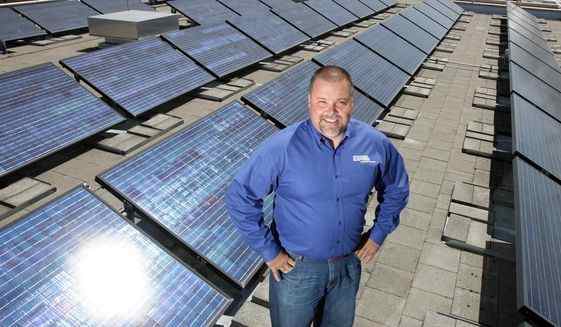forum
library
tutorial
contact

Solar Power Heating Up in Idaho
by Keith RidlerThe Washington Times, January 18, 2015
|
the film forum library tutorial contact |

|
Solar Power Heating Up in Idahoby Keith RidlerThe Washington Times, January 18, 2015 |
The 13 projects spread across southern Idaho add up to about 400 megawatts.
 BOISE, Idaho -- Idaho is going green whether it wants to or not.
BOISE, Idaho -- Idaho is going green whether it wants to or not.
The Idaho Public Utilities Commission in the last several months has approved agreements with 13 solar power projects.
A combination of federal regulations, tax incentives, cheaper solar panels and a rate-calculating method developed by the commission itself has made solar power economically attractive.
But commissioners and Idaho Power Co. officials say the projects could end up costing ratepayers more because utilities will face uncertainties by being forced by federal rules to integrate power from a source that fluctuates with the sun.
"There's a point where we can't continue to take intermittent power without harming our customers," said Idaho Power spokesman Brad Bowlin.
The 13 projects spread across southern Idaho add up to about 400 megawatts. That's enough to power up to 400,000 homes.
The Public Utilities Regulatory Policies Act, or PURPA, created in 1978 is intended to promote alternative resources. It requires power companies to buy electricity at a state commission-approved rate from qualifying small power production facilities.
The Idaho commission in a 69-page decision in December 2012 set those rates based on a methodology that paid more during peak demand times and when other power producing sources, mainly hydro, lagged.
That shifted the renewable energy field in Idaho away from wind power toward solar power. That's because, experts say, Idaho is windy in the spring and fall. In the spring, hydro projects produce plenty of energy for the region, and in the fall energy demands are reduced.
Solar power hits its peak in the summer, a time when Idaho residents turn on air conditioners.
"It wasn't too long after that (2012) case that solar power companies began enquiring," said commission spokesman Gene Fadness. "It gave some developers some certainty as to how much they would be paid."
Another factor is a tax break for solar power worth up to 30 percent of the cost of a project. That tax break is set to expire at the end of 2016, and companies must have at least part of their projects up and running before the deadline if they want the tax credit.
"Creating a profit incentive to produce clean energy is not a bad thing," said Joe Miller, an attorney and former Idaho Public Utilities Commission member from 1987 to 1995 who now represents Ketchum-based Intermountain Energy Partners.
The company has seven of the solar projects. Miller said that the price Idaho Power will pay for solar power is based on the 2012 decision and is equal to the price the utility would pay if it produced the power itself.
Idaho Power under federal regulations has to buy that solar power. Currently, the company produces about 1,700 megawatts from hydro projects, 1,100 megawatts from coal plants, and 750 megawatts from natural gas. It has a smattering of smaller power sources as well, including biomass projects and geothermal.
learn more on topics covered in the film
see the video
read the script
learn the songs
discussion forum
